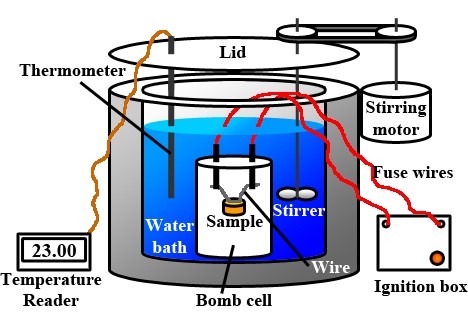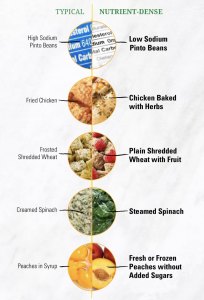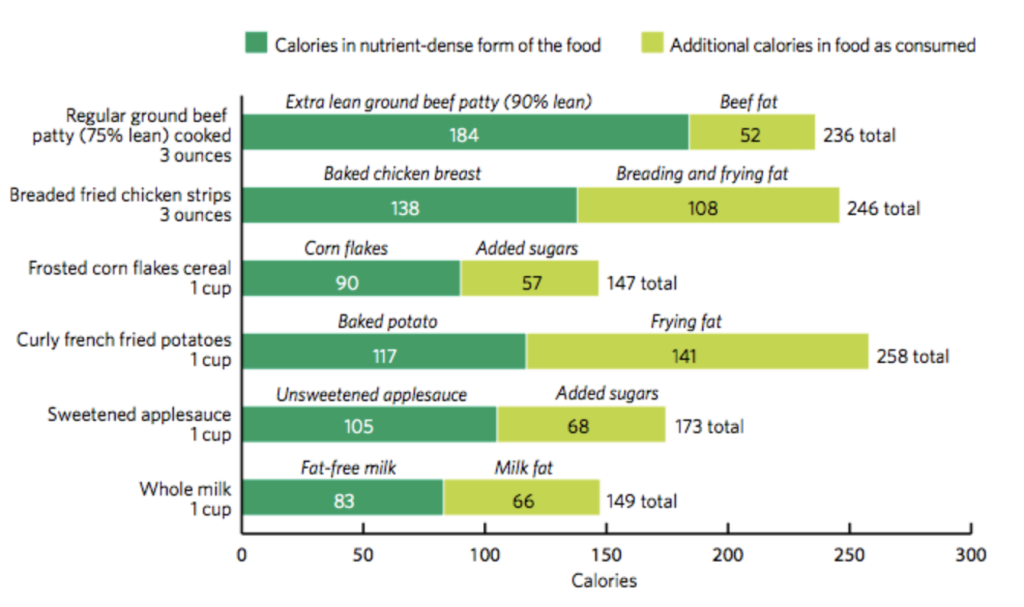Nutrients
As we saw in the previous section, many different factors affect our overall health and well-being. In this course our primary focus is on the role of dietary nutrient intake and nutrient functions in body processes.
Our bodies require dozens of different chemicals found in food to help us maintain optimal health. These chemicals are called nutrients , and the study of how these chemicals interact with each other and with our bodies is called nutrition. Nutrients are substances required by the body to perform its basic functions. We consume our favorite foods and beverages (and sometimes our not so favorites) in an attempt to gain all of the necessary nutrients to achieve or maintain our health. Sometimes we also consume supplements in addition to foods to be sure we are getting all of the required nutrients.
Although all nutrients are important, scientists categorize some as essential. The word essential means we have to have it, however, in nutrition the word essential also means we have to obtain it from an outside source, from foods or beverages. In other words, an essential nutrient is one we need that we have to consume. Non-essential nutrients are also necessary and vital for good health, but these nutrients can be made by the body in sufficient amounts as long as adequate essential nutrients are consumed, and don’t necessarily need to be a part of our daily dietary intake. Sometimes a formerly non-essential nutrient may become conditionally essential. This means that under normal circumstances a person could manufacture what they need, but if, for example, they are taking a certain medication or have a medical condition that modifies their ability to make the nutrient, then they must consume it.
Nutrients are used to help us produce energy, detect and respond to environmental surroundings, move, excrete wastes, respire (breathe), grow, and reproduce. To make it easier to study nutrients, we combine those that have similar properties or functions into groups or “classes.” There are six classes of nutrients required for the body to function and maintain overall health. These classes are carbohydrates, protein, lipids, water, vitamins, and minerals.
| Nutrient Class | Basic Functions |
| Carbohydrates | Provide a ready source of energy for the body and provide structural constituents for the formation of cells. |
| Protein | Necessary for tissue formation, cell repair, production of hormones/enzymes/neurotransmitters. Essential for building muscle and a healthy immune system. |
| Lipids | Provide stored energy for the body, functions as structural components of cells, and also as signaling molecules for proper cellular communication. Provides insulation to vital organs and works to maintain body temperature. |
| Vitamins | Regulate body processes and promote normal body system functions. |
| Minerals | Regulate body processes, necessary for proper cellular function, and comprise body tissue. |
| Water | Transports essential nutrients to all body parts, transports waste products for disposal, and aids with body temperature maintenance. |
Macronutrients
Nutrients that are needed in large amounts are called macronutrients. There are four classes of macronutrients: carbohydrates, protein, lipids, and water. Of these macronutrients, three (carbohydrate, protein, and lipids) can be metabolically processed into cellular energy and thus are called energy nutrients. The energy from macronutrients comes from their chemical bonds. This chemical energy is converted into cellular energy in the form of adenosine triphosphate (ATP) that is then utilized to perform work, allowing our bodies to conduct their basic functions. Water is also a macronutrient in the sense that you require a large amount of it, but unlike the other macronutrients it does not yield calories.

A unit of measurement of food energy is the calorie (denoted with a small “c”). A calorie is the amount of energy required to raise 1 gram of water 1° Celsius. On nutrition food labels and in the field of nutrition the amount given for “Calories” is actually equivalent to each calorie multiplied by one thousand. A kilocalorie or kcal (one thousand calories, denoted with a small “c”) is synonymous with the “Calorie” (with a capital “C”). When you see Calories on nutrition food labels it is equal to kcal (Calorie = kcal). Therefore you can use “kcal” to denote amounts of energy from food (as we have done throughout this text).
Carbohydrates
Carbohydrates are molecules composed of carbon, hydrogen, and oxygen. Any molecule that contains carbon atoms is considered an organic molecule. This use of the term organic refers only to the molecule’s chemical composition and is different from the use of the term organic in relation to how foods are grown. The main function of carbohydrates is to provide energy. The major food sources of carbohydrates are grains, milk, fruits, and starchy vegetables like potatoes. Non-starchy vegetables like broccoli or kale also contain carbohydrates, but in lesser quantities. Carbohydrates are almost exclusively found in plant-based foods. Carbohydrates are broadly classified into two forms based on their chemical structure: simple and complex.
One gram (g) of carbohydrates yields 4 kcal of energy for the cells in the body to perform work. In addition to providing energy and serving as building blocks for bigger macromolecules, carbohydrates are essential for proper functioning of the nervous system, heart, and kidneys.
All carbohydrates are made up of building blocks called monosaccharides, the most common monosaccharide is glucose. Some carbohydrates such as table sugar or honey are made of just two monosaccharides, so are called simple carbohydrates. Other carbohydrates are made up of hundreds or thousands of monosaccharides, and are called complex. Glucose can be stored for future use. In animals including humans, the storage molecule of carbohydrates is called glycogen and in plants it is known as starch. Glycogen and starches are complex carbohydrates, as is dietary fiber.
Proteins
Proteins are organic molecules composed of chains of amino acids. Amino acids are simple sub-units composed of carbon, oxygen, hydrogen, and nitrogen. The food sources of proteins are meats, dairy products, seafood, and a variety of different plant-based foods, most notably soy. The word protein comes from a Greek word meaning “of primary importance,” which is an apt description of these macronutrients; they are also known colloquially as the “workhorses” of life. Proteins provide 4 kcal of energy per g; however providing energy is not protein’s most important function. Proteins provide structure to bones, muscles and skin, they make up hormones, enzymes, neurotransmitters, and molecules important in immunity, and play a role in conducting most of the chemical reactions that take place in the body. Scientists estimate that greater than 20,000 different proteins exist within the human body.
Lipids
Lipids are also a family of organic molecules composed of carbon, hydrogen, and oxygen, but unlike carbohydrates, they are insoluble in water. Lipids are found predominantly in butter, oils, meats, dairy products, nuts, and seeds, and in many processed foods. The three main types of lipids are triglycerides (or triacylglycerols), phospholipids, and sterols. The main job of lipids is to store energy. Lipids provide more energy per g than carbohydrates or protein (9 kcal per g of lipids versus 4 kcal per g of carbohydrates/protein). In addition to energy storage, lipids serve as components of cell membranes, surround and protect organs, aid in temperature regulation, and regulate many other functions in the body.
Water
There is one other nutrient that we must consume in large quantities: water. Water does not contain carbon, making it an inorganic molecule. It is composed of two hydrogen (H2) and one oxygen (O) per one molecule of water. More than 60% of your total body weight is water. Without it, nothing could be transported in or out of the body, chemical reactions would not occur, organs would not be cushioned, and body temperature would fluctuate widely. On average, an adult consumes just over two liters of water per day from food and drink. According to the “rule of threes,” a generalization supported by survival experts, a person can survive three minutes without oxygen, three days without water, and three weeks without food. Since water is so critical for life’s basic processes, the amount of water input and output is supremely important. However, water does not provide any kcal. So it is considered a macronutrient, but not an energy nutrient.
Alcohol is not considered a nutrient, although it is a source of kcal. Remember that a nutrient is something that is necessary for body functioning and overall health. Alcohol does not meet that definition of a nutrient. Alcohol itself provides approximately 7 kcal for every g consumed. In addition to alcohol, many alcoholic drinks contain additional kcal from other nutrient classes—especially carbohydrates.
Micronutrients
Micronutrients are nutrients required by the body in very small amounts, but are still essential for carrying out bodily functions. Micronutrients include all the essential minerals and vitamins. There are 13 essential vitamins and 16 minerals (see Table 1.3.2 and Table 1.3.3 for a complete list and their major functions). In contrast to carbohydrates, protein, and lipids, micronutrients are not directly used for making energy and do not contain kcal, but they assist in the process of energy production as part of enzymes (i.e., coenzymes). Enzymes are proteins that catalyze chemical reactions in the body and are involved in all aspects of body functions from producing energy, to digesting nutrients, to building macromolecules. Micronutrients play many roles in the body.
Vitamins
The 13 vitamins are categorized as either water-soluble or fat-soluble. The water-soluble vitamins are vitamin C and all the B vitamins, which include thiamin, riboflavin, niacin, pantothenic acid, B6, biotin, folate and B12. The fat-soluble vitamins are A, D, E, and K. Vitamins are required to perform many functions in the body such as making red blood cells, synthesizing bone tissue, and playing a role in normal vision, nervous system function, and immune system function.
Vitamin deficiencies can cause severe health problems. For example, a deficiency in niacin causes a disease called pellagra, which was common in the early twentieth century in some parts of America. The common signs and symptoms of pellagra are known as the “4D’s—diarrhea, dermatitis, dementia, and death.” Until scientists found out that better diets relieved the signs and symptoms of pellagra, many people with the disease ended up in asylums awaiting death. The deficiency of other vitamins was found to cause other disorders and diseases such as scurvy (vitamin C), night blindness (vitamin A), and rickets (vitamin D).
| Vitamins | Major Functions |
| Water-soluble | |
| Thiamin (B1) | Coenzyme, energy metabolism assistance |
| Riboflavin (B2) | Coenzyme, energy metabolism assistance |
| Niacin (B3) | Coenzyme, energy metabolism assistance |
| Pantothenic acid (B5) | Coenzyme, energy metabolism assistance |
| B6 (Pyroxidine) | Coenzyme, amino acid synthesis assistance |
| Biotin (B7) | Coenzyme |
| Folate (B9) | Coenzyme, essential for growth |
| B12 (Cobalamin) | Coenzyme, red blood cell synthesis |
| C | Collagen synthesis, antioxidant |
| Fat-soluble | |
| A | Vision, reproduction, immune system function, antioxidant |
| D | Bone and teeth health maintenance, immune system function |
| E | Antioxidant, cell membrane protection |
| K | Blood clotting, bone and teeth health maintenance |
Minerals
Minerals are solid inorganic substances that form crystals and are classified depending on how much of them we need. Trace (minor) minerals such as molybdenum, selenium, zinc, iron, and iodine, are only required in a few milligrams (mg) or less per day while major minerals such as calcium, magnesium, potassium, sodium, and phosphorus, are required in hundreds of mg. Like vitamins, minerals do not contain kcal. Many minerals are critical for enzyme function, others are used to maintain fluid balance, build bone tissue, synthesize hormones, transmit nerve impulses, contract and relax muscles, and protect against harmful free radicals.
| Minerals | Major Functions |
| Major | |
| Sodium | Fluid balance, nerve transmission, muscle contraction |
| Chloride | Fluid balance, stomach acid production |
| Potassium | Fluid balance, nerve transmission, muscle contraction |
| Calcium | Bone and teeth health maintenance, nerve transmission, muscle contraction, blood clotting |
| Phosphorus | Bone and teeth health maintenance, acid-base balance |
| Magnesium | Protein production, nerve transmission, muscle contraction |
| Sulfur | Protein production |
| Trace/Minor | |
| Iron | Carries oxygen, assists in energy production |
| Zinc | Protein and DNA production, wound healing, growth, immune system function |
| Iodine | Thyroid hormone production, growth, metabolism |
| Copper | Coenzyme, iron metabolism |
| Selenium | Antioxidant |
| Chromium | Assists insulin in glucose metabolism |
| Manganese | Coenzyme |
| Molybdenum | Coenzyme |
| Fluoride | Bone and teeth health maintenance, tooth decay prevention |
To review, the dozens of nutrients that the body requires are grouped into six classes based on form and function. Below is a summary of the characteristics of the six nutrient classes.
| Class of Nutrient | Macro- or Micronutrient | Organic Nutrient (contains carbon) | Energy Nutrients |
| Carbohydrates | Macro | Yes | Yes – 4 kcal/g |
| Protein | Macro | Yes | Yes – 4 kcal/g |
| Lipids | Macro | Yes | Yes – 9 kcal/g |
| Vitamins | Micro | Yes | No |
| Minerals | Micro | No | No |
| Water | Macro | No | No |
Food Energy
As discussed previously, food energy is measured in Calories and commonly referred to as kcal. Though this is only the first chapter you have already seen the words “kcal” and “energy” used several times. In everyday life you have probably heard people talk about how many calories (kcal) they burned on the treadmill or how many calories are listed on a bag of chips. Kcal are a measure of energy. It takes quite a lot of kcal (energy) to keep us alive. Even if a person is in a coma, they still burn approximately 1000 kcal of energy every day in order for their heart to beat, their blood to circulate, their lungs to breathe, etc. We burn even more kcal when we exercise. A food’s kcal are determined by putting the food into a bomb calorimeter, heating it, and measuring the energy output (energy = heat produced). The carbohydrates, proteins, and fats we eat and drink provide these kcal for us (and alcohol as well if we choose to consume it).

Food Quality

One measurement of food quality is the amount of nutrients it contains relative to the amount of energy it provides. High quality foods are nutrient dense, meaning they contain many nutrients relative to the amount of calories they provide. A food with high nutrient density would have a large amount of various beneficial nutrients in each “bite” of that particular food. Because “bites” are different for everyone, we use common measures such as gram (g), ounce (oz), cup (c), pound (lb), liter (L), tablespoon (tbs), etc. to help us compare different foods. (See common measures used in Appendix 1). Determining nutrient density of a food is not straightforward. One must consider the nutrient profile of a food as a whole, and it can be quite subjective. However, it is generally agreed that whole fruits and vegetables, 100% whole grains, nuts, and legumes tend to have high nutrient density. Food quality is additionally associated with its taste, texture, appearance, microbial content, and how much consumers like it.
Another measure of food quality is to examine the number of kcals in a food relative to the size of each “bite.” The term used to describe this is energy density or calorie density. Foods high in fats and sugars, like fast food burgers, pizza, candy bars, etc. would be considered energy dense since they provide many calories per bite but are typically lacking several essential vitamins, minerals, and other beneficial nutrients like fiber. We can compare the energy density of different foods if we know the number of kcals and the size of a serving for each.

A third term often used to describe food quality is “empty calorie.” Foods such as carbonated sugary soft drinks provide many calories, but very few, if any, beneficial nutrients, making the calories “empty.”
We can compare meals to examine food quality:
Let’s say we have a choice between two different breakfasts depicted in the images below. Each breakfast contains 500 kcal. But breakfast #2 provides many more nutrients inthose 500 kcal than do the donuts. There are several different vitamins and minerals in the two types of berries and in the spinach. These fruits and vegetable also contain fiber, and there is lean protein in the eggs. The donuts in breakfast #1 contain 500 kcal as well, but those kcals are primarily fat and sugar. There are very few vitamins or minerals in the donuts, and almost no fiber or protein. Therefore, breakfast #2 is more nutrient dense.
We can also compare the energy density of the two breakfasts. Because we know the weights of the two (in grams) and that both contain 500 kcal, we can calculate the energy density of each breakfast.
Energy density of breakfast #1: 500 kcal/135 g = 3.7 kcal per gram of food
Energy density of breakfast #2: 500 kcal/350 g = 1.4 kcal per gram of food
Breakfast #1 has more than 2.5 times as many kcal per gram of food than breakfast #2. Therefore breakfast #1 has higher energy density.


Super Foods
Often you see lists of “Super Foods” on the internet or in magazines. These superfoods (also called “functional foods”) are generally understood to be a food, or a food ingredient, that may provide a health benefit beyond the traditional nutrients it contains.[1] These functional foods tend to be whole (not processed) vegetables and fruits like kale or Swiss chard, legumes, or berries, or animal foods like cold water fish. They are considered highly nutritious because they contain not only beneficial nutrients, but also additional beneficial chemical compound(s) that are not nutrients (also called non-nutritive).Phytochemicals are non-nutritive chemical compounds found in plants (phyto) that provide characteristics to the plant like color, taste, smell. They are found in the edible parts of plants, especially the skin or peel. However, these plant chemicals are also believed to provide health benefits beyond the traditional nutrients. According to the Harvard Medical School, it is estimated that about 5,000 have been identified so far, but we don’t yet know what they all do.[2] General categories of phytochemicals include (but are not limited to) carotenoids, flavonoids, and phenols.
Diets rich in fruits and vegetables have been associated with decreased risk of chronic diseases. Many fruits and vegetables are rich in phytochemicals, especially when consumed whole, leading some to hypothesize that phytochemicals are responsible for the decreased risk of chronic diseases. The role that phytochemicals play in health is still in the early stages of research. But you may be able to reduce your risk of chronic disease by consuming high amounts of whole fruits and vegetables to raise your intake of these phytochemicals. However, benefits seem to only come from the plant itself, and not from dietary supplements containing the phytochemical.
references
Chapter 1, section 1.3 from Consumer Nutrition by Megan Grimsley and Susan Kazen published in 2021 under a CC BY-NC-SA license.
- Klemm, S. (2019, July 15). Functional foods. Academy of Nutrition and Dietetics. https://www.eatright.org/food/nutrition/healthy-eating/functional-foods ↵
- Harvard Health Letter. (2019, February). Fill up on phytochemicals. Harvard Medical School. https://www.health.harvard.edu/staying-healthy/fill-up-on-phytochemicals ↵
chemicals found in food essential for health
study of how nutrients interact with each other and with the body
required by the body, and it must be consumed in the diet
nutrients that can be manufactured by the body in adequate amounts so consumption is not required
a normally non-essential nutrient that becomes essential due to a disease, condition, or medication
Classes of nutrients needed in relatively large amounts. These include carbohydrate, protein, lipid, and water.
macronutrients that can provide energy in the form of kilocalories (kcal)
chemical energy obtained from the breakdown of food molecules and released to fuel cellular processes
unit of measurement of food energy; the amount of energy required to raise 1 kilogram of water 1 degree Celsius.
one thousand calories, denoted as kcal or Calorie (capital C) on nutrition food labels
term used in chemistry to denote that a molecule contains the carbon atom
main form of carbohydrate in the body
stored form of glucose in animals including humans; stored in liver and skeletal muscle
stored form of carbohydrate in plants
building blocks of protein
body fat
Lipid transport molecule surrounded by bile salts allowing dietary lipids to be absorbed into the walls of the small intestine
Food or beverages such as sugary sodas or candy containing calories but no beneficial nutrients

